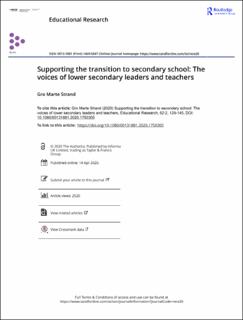| dc.contributor.author | Strand, Gro Marte | |
| dc.date.accessioned | 2021-06-07T11:17:09Z | |
| dc.date.available | 2021-06-07T11:17:09Z | |
| dc.date.created | 2020-05-18T09:22:05Z | |
| dc.date.issued | 2020 | |
| dc.identifier.citation | Educational Research. 2020, . | en_US |
| dc.identifier.issn | 0013-1881 | |
| dc.identifier.uri | https://hdl.handle.net/11250/2758186 | |
| dc.description.abstract | The primary-secondary transition is recognised as a challenging time for students, and poor transition processes can negatively affect the students’ development. School professionals play an important role in enhancing the students’ transition experience, but international literature calls for more research concerning their perspective on this transition. Purpose: The aim of this study was to investigate what lower secondary school leaders and teachers in Norway emphasise when supporting the primary to lower secondary school transition. Methods: A qualitative single case study approach was used. The participants were ten form teachers, their team leader and the principal (n = 12) within one lower secondary school. These were the individuals overseeing the transition process on behalf of a cohort of students who transferred to their school in August 2017. Data were collected through observations and focus group interviews. The data were transcribed and analysed qualitatively, inspired by the constant comparative method of analysis. Findings and conclusion: Framed by their own experiences, the leaders and teachers emphasised ensuring predictability, establishing a safe psychosocial learning environment, giving the students time to learn to be lower secondary school students, and collaboration at the school level and with the families. These efforts are largely in line with what the research recommends. The findings indicate, however, that the teachers need more support during this process. The article concludes that a closer dialogical interaction with colleagues at the primary and secondary levels, parents and students could support the leaders and teachers to promote an even better transition. | en_US |
| dc.language.iso | eng | en_US |
| dc.publisher | Taylor & Francis | en_US |
| dc.rights | Attribution-NonCommercial-NoDerivatives 4.0 Internasjonal | * |
| dc.rights.uri | http://creativecommons.org/licenses/by-nc-nd/4.0/deed.no | * |
| dc.title | Supporting the transition to lower secondary school: The voices of lower secondary leaders and teachers | en_US |
| dc.type | Peer reviewed | en_US |
| dc.type | Journal article | en_US |
| dc.description.version | publishedVersion | en_US |
| dc.source.pagenumber | 18 | en_US |
| dc.source.journal | Educational Research | en_US |
| dc.identifier.doi | 10.1080/00131881.2020.1750305 | |
| dc.identifier.cristin | 1811423 | |
| dc.description.localcode | © 2020 The Author(s). Published by Informa UK Limited, trading as Taylor & Francis Group. This is an Open Access article distributed under the terms of the Creative Commons Attribution-NonCommercial-NoDerivatives License (http://creativecommons.org/licenses/by-nc-nd/4.0/), which permits non-commercial re-use, distribution, and reproduction in any medium, provided the original work is properly cited, and is not altered, transformed, or built upon in any way | en_US |
| cristin.ispublished | true | |
| cristin.fulltext | postprint | |
| cristin.qualitycode | 2 | |

